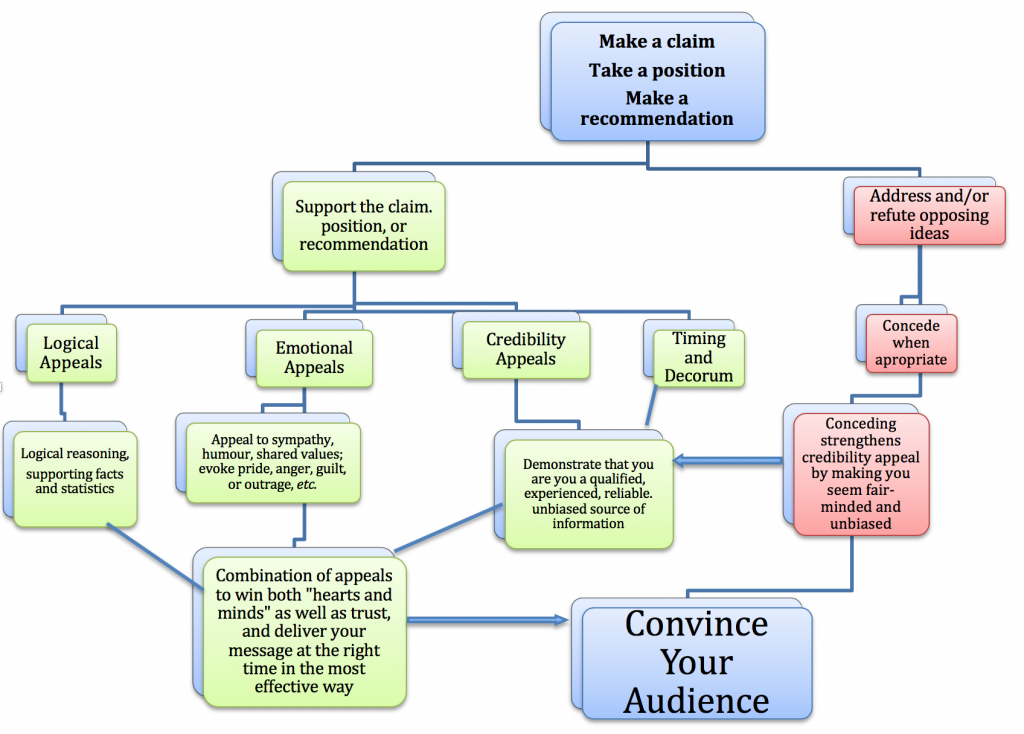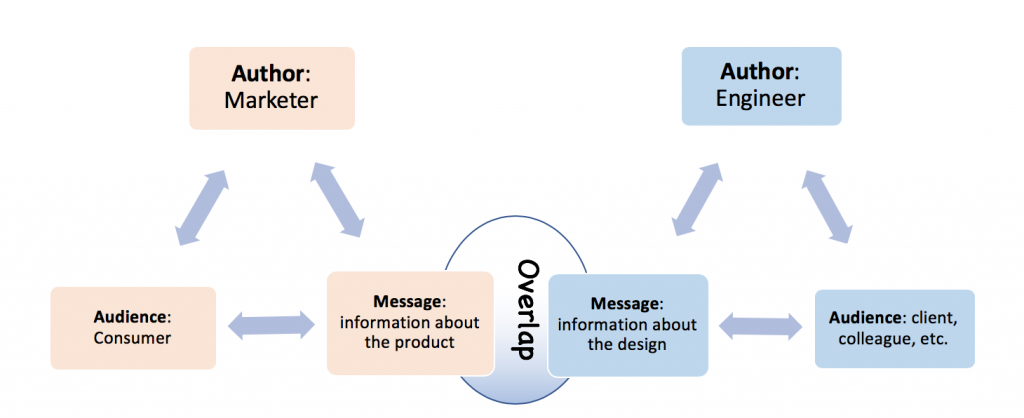2.3 Writing To Persuade
Persuasion involves putting forth a compelling argument to reinforce or otherwise influence behaviour, action, and motivation. Sometimes, you may want to persuade your reader to take a particular action or position on an issue. To be effective, you should consider how to make effective use of the following elements of persuasion, often referred to as rhetorical appeals. The ancient Greek words are ethos, pathos, logos, and kairos (see Figure 2.3.1):
(Three Persuasive Appeals, 2017)
A fuller explanation of each appeal follows.
- Ethos – Appeal to Credibility/Authority: This element of persuasion involves establishing your credibility, expertise, or authority to be making the argument. What experience or expertise do you have? What knowledge or skills do you possess? What’s your role within the organization and/or in relation to the reader? Why should the reader trust you as a reliable, knowledgeable, authoritative, and ethical source of information? For example, when writing a proposal, establishing your credibility will help to inspire confidence in your abilities to do what you are offering to do.
- Pathos – Appeal to Emotion/Interest/Values: This element involves appealing to the emotions, values, and/or interests of the reader. How does your proposal benefit them? Why should they care about it? How does it relate to the goals of the organization? How can you build “common ground” with your reader? What will make your reader feel “good” about your project? How can you evoke emotions such as pride or outrage?
- Logos – Appeal to Reason/Logic: This element involves grounding your argument in logic, reason, and evidence. What evidence supports your claims? On what facts and data is your reasoning based? Arguments grounded in reason and evidence are often considered the strongest. Government organizations and companies alike generally like to make “evidence-based decisions.” In a proposal, for example, providing evidence on the soundness of your proposed action would help to convince the reader that you have done your research and that your methods are grounded in facts.
- Kairos – Appeal to Timeliness/Appropriateness: Using this appeal means being aware of what is appropriate and timely in a given rhetorical situation. Sometimes, a well-crafted argument can fail because it comes at the wrong time. Kairos involves knowing what is “in” or “hot” right now, what is an important topic or issue, and how best to discuss it; knowing when it is the “right time” to broach a topic or propose an idea; knowing how to use the appropriate tone, level of formality and decorum for the specific situation. For example, having knowledge of current trends and innovations in a subject makes you able to speak to future probability.
Emotional appeal alone is used sparingly in business communication unless it is for marketing purposes. Regardless, finding the appropriate blend of appeals is critical to making a successful argument. Consider that when making your case, you often have to “win both hearts and minds”—so you’ll need to appeal to both emotions and logic. Assess the context and audience to plan your approach. Do whatever you can to show the reader that you are a trustworthy source of information, and present your argument at the most opportune time. Also be mindful of the word choice and tone so that you are presenting a persuasive argument that is constructive and conveys the appropriate tone for your intended audience, message, and purpose.

Knowledge Check
Avoiding Ad-Speak
“Ad-Speak” refers to the kind of language often used in advertisements. Its aim is to convince consumers to buy something, whether they need it or not, hopefully without thinking too much about it. Because we hear this kind of rhetoric all the time, it easily becomes a habit to use it ourselves. We must break this habit when communicating in professional contexts.
Ad-Speak tends to use strategies such as
- emotional manipulation
- logical fallacies
- exaggeration or dishonesty
- vague claims
- incomplete or cherry-picked data
- biased viewpoints
- hired actors rather than professionals or experts as spokespeople
As a student in a business or computer studies program learning the specialized skills and developing the sense of social obligation needed to become a trusted professional, you should avoid using “sensational” words characteristic of marketing language. Instead, when trying to persuade your reader, make sure you use quantifiable, measurable descriptors and objective language in your writing. You cannot determine how many units of “excellence” something has, or its quantifiable amount of “awesomeness,” “fantastic-ness,” or “extraordinariness.” Describing something as “incredible” literally means it’s unbelievable. So avoid using these kinds of words shown in Figure 2.3.2.

Rather, find measurable terms like “efficiency” (in time or energy use), “effectiveness” at fulfilling a specific task, measurable benefits and/or costs, or even “popularity” as measured by a survey.
Communicating Ethically
In professional writing, communicating ethically is critically important. Ethical communication involves communicating from a place of accountability, responsibility, integrity, and values. If you are communicating ethically, you are demonstrating respect for your reader, the organizations you work for and with, and the culture and context within which you work. You also foster fairness and trust through honesty. Failure to maintain integrity and ethics can result in consequences ranging from damage to reputation, loss of work, lawsuits, or even criminal charges.
This is precisely why many professional associations have guidelines that govern the ethical behaviour of their membership. Two such documents that offer good examples are the Canadian Information Processing Society’s (CIPS) Code of Ethics and Standards of Conduct and the Chartered Professionals in Human Resources of Canada Code of Ethics and Rules of Professional Conduct.
Principle P3: Members have a duty to act in the best interest of their clients and employers. Particularly,
P308 A Member shall provide informed views and recommendations and always render objective and independent advice.
P309 A Member shall endeavour to act in an impartial and unbiased manner and shall act in good faith towards all parties at all times.
P310 A Member shall maintain complete and appropriate records as might be reasonably expected for the matter for which they are engaged.
P311 A Member shall be clear in communications with clients and employers, and where appropriate, shall confirm arrangements and understandings in writing, including the scope of the engagement objectives, nature of services to be rendered, proposed work plan, identities and qualifications of the assignment team, and fees, and billing arrangements including the treatment of expenses, disbursements, and applicable taxes
It is important to become familiar with such standards of practice and to consider how they impact communication practices. Remember that you are communicating in a professional context, and that comes with responsibility. Consider the different rhetorical situations diagrammed in Figure 2.3.3, one for a marketer and one for an engineer.

Clearly, there may be some overlap, but there will also be significant differences based on the needs and expectations of the audience and the kind of message being delivered. We hear marketing language so often that it is easy to fall into the habit of using it, even when it’s not appropriate. Make sure you are not using “ad-speak” when trying to persuade in a professional context.
Knowledge Check
Knowledge Check
References
Chartered Professionals in Human Resources of Canada. (2016). Code of ethics and rules of professional conduct. https://cphr.ca/wp-content/uploads/2017/01/2016-Code-of-Ethics-CPHR-2.pdf
CIPS. (2018, June). CIPS code of ethics. Official Website of CIPS. https://cipsresources.ca/ethics/
Last, S. (2019). Technical writing essentials. https://pressbooks.bccampus.ca/technicalwriting/
Ulmer, K. (2017). The three persuasive appeals: Logos, ethos, and pathos [Video]. Youtube. https://www.youtube.com/watch?v=-oUfOh_CgHQ
Image descriptions
Figure 2.3.1 image description:
Use rhetorical appeals to convince your audience of a claim or recommendation you’ve made or a position you’ve taken. From there, you can support your claim using different types of appeals or address and refute opposing ideas.
To support the claim, position, or recommendation, you can use different types of appeals:
- Logical appeals: Use logical reasoning along with supporting facts and statistics.
- Emotional appeals: Appeal to sympathy, humour, shared values or use specific words to evoke pride, anger, guilt, or outrage, etc.
- Credibility appeals and Timing and Decorum: Demonstrate that you are qualified, experienced, reliable, and an unbiased source of information
Use a combination of appeals to win both “hearts and minds” as well as trust, and deliver your message at the time in the most effective way.
When addressing and/or refuting opposing ideas, it’s okay to concede where appropriate. Conceding strengthens credibility appeal by making you seem fair-minded and unbiased. You may need to draw on credibility appeals to show that you are qualified, experienced, and a reliable, unbiased source of information.
Supporting your position using different types of appeals and addressing opposing ideas will allow you to convince your audience.
Figure 2.3.3 image description:
When the marketer is the author, their audience is the consumer and their message is information about the product. When the engineer is the author, their audience could be a client or colleague, and their message is information about the design. There may be some overlap between the messages of the marketer and the engineer.

